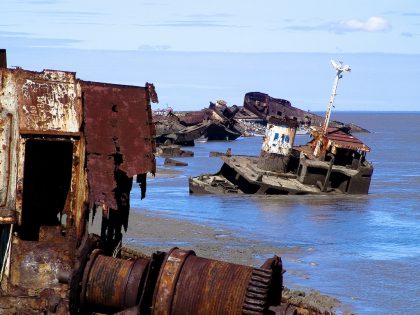Waterless scars and pipe dreams in Nairobi
Poor Nairobi residents pay close to four times more for water that is much less clean, adequate or consistent.

Children fetching water. Image credit Annie Pfingst.
There will be no long rains in Kenya this year. After a season of much higher than normal temperatures, the meteorological department finally confirmed what we least hoped for: more famine, more drought.
But many segments of the population have already been living in drought conditions for years across our republic: an estimated 41% of Kenyans still use “unimproved water sources, such as ponds, shallow wells and rivers” to access this resource. Considering we just paid 447 billion Kenya shillings (roughly $3.2 billion) for a geriatric train, there is really no reason why citizens don’t have any water.
While participating in community research on water rights in the East of Nairobi, more popularly known as Eastlands, one mother told us that sometimes she has to choose between using water to wash her baby or to cook. Other family members told us about how children died a day after drinking unclean water, and another elderly aunty told us about how the water she has access to smells and looks like sewage. In this same locality, a small NGO clinic reported that they received, at least, 15 cases of cholera and 200 cases of typhoid every day.
This is happening even as the Governor of Nairobi continues to promise “water for all.”
Granted the dry taps, ponds and dams are now exacerbated by climate change, a process beyond both our making and the continent’s sole control, as the floods in Mozambique tragically demonstrate. However, many Kenyans have already been living in situations of semi-permanent drought, as have historically lacked access to the “clean, safe and adequate water” provided for in the 2010 Constitution.
Much of their day is then spent looking for water: waiting for it to arrive, holding jerri cans in the line behind a tap or broken pipe, and then storing in in whatever medium is available.

Rich people can overcome water limits (and still drench their immaculate lawns) by either having their own boreholes, conducting rich people advocacy and even, get this, creating their own water company as Runda (enclave of embassies, UN and embassy staff) did. And even when there is water rationing, they get timetables for when it will disappear.
Meanwhile, a few kilometres from Runda, on the other side of Thika Superhighway, residents are drinking one glass of water a day, even when our County water budget is 360 million shillings (36 million dollars). They don’t have water pipes, and so that means that they have to purchase unsafe water from unreliable sources. As a consequence,
for our city’s majority in poor urban settlements, “cholera inabeba watu kama transporter”—cholera is carrying people away like a truck.
And they still pay more for this cholera-infested water.
Indeed the costs are excessive. Vincent Ng’ethe at Africa Check writes that:
At KSh2 per 20 l jerrycan, slum dwellers pay KSh100 per m³, increasing to a massive KSh2,500 per m³ when the price is at KSh 50 per jerrycan. In comparison, residential customers of the Nairobi Water Company pay KSh204 for their first 6,000 l (KSh29.4 per m³), KSh53 for water use between 7,000 and 60,000 l and KSh64/m³ thereafter. Those living in flats or gated communities pay KSh53 per m³ for bulk supply.
Ultimately, poor Nairobi residents pay close to four times more for water that is much less clean, adequate or consistent.
All the small business owners, local activists, mothers, students and, even, carwash operators who took part in our participatory research on water rights know this intimately.

Like those in Flint, Palestine, Khayelitsha and beyond, they know that the lack of water is not an issue of a limited public purse, but rather state will. It is also a business. Cartels at both the Nairobi County level and the Nairobi Water and Sewerage Company create shortages, control the supply and the cost of water. They also neglect or don’t establish much needed water infrastructures for poor residents, and even, it is rumored, prevent neighborhoods susceptible to fires from getting water hydrants because these could potentially give residents free water.
When community members devise their own means of getting what the County of Nairobi/Nairobi Water and Sewerage Company deem “illegal” or “non-revenue” water, they are violently penalized.
Because of this, Eastlands residents involved in the water rights research demanded that the government:
- Restructure systems to make sure that water is not privatized and is accessible to all
- Close bottled water companies since they are cartels
- Build safe, secure and adequate piped water networks in all marginalized neighborhoods in Nairobi and in other counties, and close all cartels associated with the Nairobi City Water and Sewerage Company
- Distribute water according to population density and not according to wealth
- Improve and increase sanitation facilities in all marginalized neighborhoods to prevent diseases like cholera and typhoid.
- Provide free health care services for those affected by inadequate and dirty water, sanitation and sewage infrastructures
- Improve water policies, comprehensively implement the current water legislation, and include strong people-centered accountability mechanisms
- Install fire hydrants in all marginalized neighborhoods with frequent fires
- All water bodies should have at least three representatives from poor urban settlements on their board. These should include a woman, a community activist, and a person with a disability chosen by the community
- Impeachment of all presidents, governors and water company CEOs who do not implement article 43 of the Kenyan Constitution.
While impeachment of all presidents, governors and water company CEO’s would be the best case scenario, for now residents just want some water: there are too many “waterless scars” one said, and water infrastructure should not be a pipe dream.







